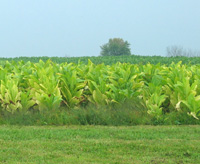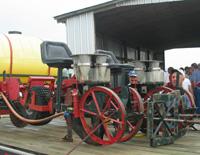No-Till Tobacco Research Continues To Improve Techniques
No-Till Tobacco Research Continues To Improve Techniques


No-till planter
Decades worth of no-till tobacco research by the University of Kentucky College of Agriculture are proving the system can be an effective and ecological means of producing tobacco.
“We still are learning but are far enough along in research to know we can make it work and with some patience can apply it to a wide range of soils,” said Bob Pearce, UK Extension tobacco specialist.
Pearce has nearly 11 years of research experience with no-till production and research at UK has been under way about 21 years. In recent years, scientists have made good progress particularly in terms of weed control, he said.
The main reason for looking at no-till production in tobacco is soil conservation. A no-till tobacco field at a Glendale farm alongside a conventionally tilled field made the perfect backdrop for this point. The conventionally tilled area had washed and created ditches within the field. No-till tobacco planted at the same time showed no erosion.
It also helps to preserve moisture in the soil, which in most years in Kentucky , is a good thing, Pearce said. This year and for the past two or three years, moisture preservation hasn’t been a factor because of an abundance of rain.
Pearce cautioned that even though the ground may be firmer with no-till, it cannot be planted earlier than conventional tilled.
“Our experience has been that it’s about two or three days after you can start planting conventional before you can start planting on no-tilled ground,” he said. “The mulch or surface layer holds the moisture in and keeps that ground moist for longer.”
Reduced field preparation is another positive for no-till tobacco production.
No-till production can allow producers to get into the field and spray when wet conditions wouldn’t allow entry into conventionally tilled patches. That could be of particular advantage in a year such as this one when blue mold was being seen across the state.
In general where tilled and no-till tobacco are planted side by side, conventional tobacco gets up and growing faster but by harvest the difference has often evened out and both are capable of producing a quality crop.
“One of the hurdles that we had to get over was getting plants into the ground,” he said.
Several planter alterations were tried before coming up with one that works well. The transplanter has been modified to include a front coulter to remove and cut any surface residue and to provide a little tillage for the plant to be placed. A subsoiler that runs just below and ahead of the shoe also has been added to pull it into the ground. It also loosens the soil underneath where the root ball is going to go, allowing it to get a good start. The press wheels were modified to be narrower and flat in order to close the ground better around the plant.
Cover crop management also is extremely important.
“We learned that cover crops need to be burned down fairly early in the season, otherwise they can work like a weed and compete with the tobacco plant,” he said, “This is especially true with wheat or rye, which grows very rapidly in the spring. As it does this it is using a lot of nutrients and moisture.”
In early research, heavy cover crops were planted to help alleviate weed problems but that didn’t work well; instead it slowed the growth of the tobacco and resulted in questions about the feasibility of no-till tobacco production, Pearce said. But it was just a matter of finding the right combination of management to get it to work.
Producers planning to no-till tobacco into sod should kill the sod in the fall prior to planting the tobacco. Fall burn down allows time for the sod’s root mass to breakdown. This is particularly important in hay and pasture fields because it gives producers time to deal with some of the more troublesome perennial weeds such as vines and cockleburs.
Weed control had been hit or miss in no-till tobacco before the herbicide Spartan came along, Pierce said, but farmers still need to go into locations that have had pretty good weed control in the past. There are some, but not a lot, of over-the-top options to control weeds in tobacco as the growing season progresses.
Research has focused on doing it without tillage but some cultivating can be done in no-till tobacco to control weeds but it must be done carefully, Pearce said.
As research continues into tobacco production methods, conservation tillage is another area that may be added to the mix.
For more information on no-till tobacco production, contact your local county Extension office.
-30-
